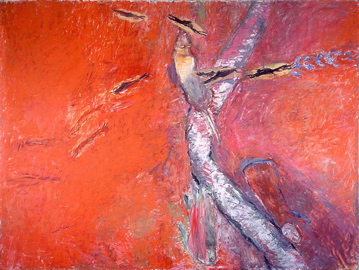
Susan Rothenberg, "Galisteo Creek", 1992
This week I’d like to breathe a blissful sigh after a quiet vacation AND take on the Flashpoints question for August…
Does art expand our ability to imagine?
My gut reaction is Yes, but it can deaden that ability, too. Let’s face it, bad art or art that has become wallpaper over time can prohibit the imagination from taking off at all. I’m thinking of classrooms or studios that hardly ever change. The same things hang on the walls and take strategic positions in the floor plan year after year. The same posters and the same, um, motivational banners (you know… YOU CAN DO IT, etc.) become a brittle yellow after semesters of hanging on for dear life by four pieces of masking tape.
Art studios and classrooms where students and aspiring artists learn have the opportunity to inspire and nudge the imagination through their very presence in the space. For example, having two different places in a room dedicated to visuals related to the current unit of study and to new art and artists being “discovered” by students and teachers creates a scenario where very different art is often being juxtaposed and discussed. This leads to students asking questions, and we all know good questions is what it’s all about. Obviously, having another area or separate gallery display space for student work samples from the most recent unit can provoke ideas and possible options for the current theme or question students are exploring.

Gabriel Orozco, production still, 2003
Now, if you’re working in a classroom on a daily basis, I know what many of you are thinking:
- What if I don’t have the space (or a room!)?
- Where do I find visuals?! I’m lucky to have a computer, and the only visuals in my classroom are bad freebies from conferences in 1986 and 1992, respectively.
Let’s look at each of these questions, at least one of which probably apply in a vast majority of classrooms all over the country.
If you do not have the space or are faced with the huge challenge of traveling to different classrooms to teach art, visuals can be “stored” (and sometimes, in a way that’s even more organized than having a space in the classroom) on flip charts and displayed when required on a simple easel. The flip chart pad can be arranged by units of study. While it may be cumbersome to carry around, it’s certainly better than shuffling magazine cutouts and trying to “share” these with classes of 30 or more.
If you are in a position where your school, district or university simply doesn’t have funding to update print and poster samples (and at this point, who does?), then slideshows shared in the classroom and later e-mailed to students can have positive effects as far as expanding student thinking. As a matter of fact, some students will appreciate the opportunity to linger on images outside of the classroom. Teachers can also make good use of free resources from museums, alternative spaces and galleries (press kits, anyone?) in order to keep the images hanging in the classroom thought-provoking rather than mind-numbing.
I think most art educators believe art can absolutely expand our ability to imagine. We just need to steer clear of the wallpaper.
Both Susan Rothenberg’s “Galisteo Creek” and the photograph of Gabriel Orozco were compared in a classroom conversation about taking “artist walks”.



